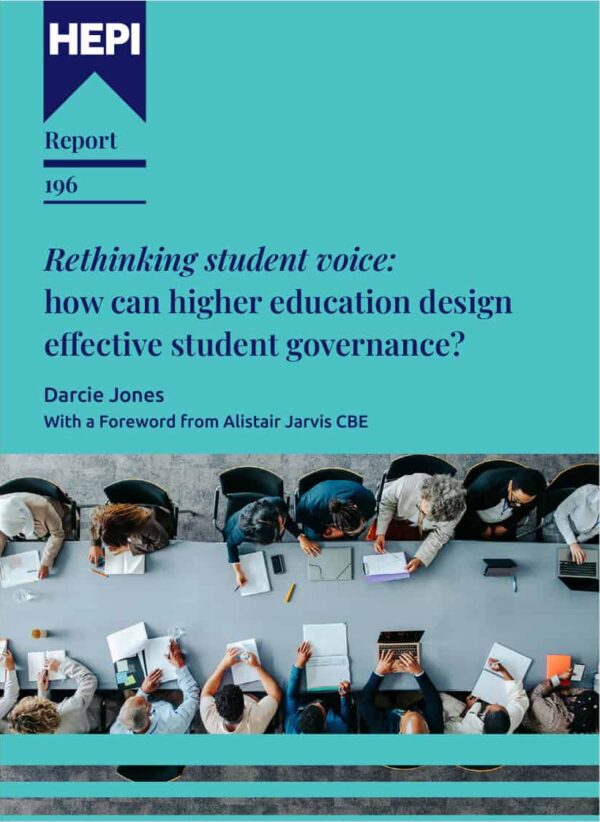WEEKEND READING: The Renters’ Rights Act: How will students’ tenancies change and when?
This blog was kindly authored by Martin Blakey, the former Chief Executive of the student housing charity Unipol and a member of the British Property Federation’s Student Accommodation Committee.
On Wednesday, 22 October 2025, the Renters’ Rights Bill passed through its final stage in a thinly occupied Commons chamber, and obtained Royal Assent on 28 October. HEPI has taken a close interest in how the Act’s changes would affect students, and a number of previous blogs that have charted the Bill’s progress are listed at the end of this one.
The Bill has a long history, first appearing under the previous Conservative government under the title the Renters’ Reform Bill in May 2023 and then being resubmitted, after some redrafting, by the new Labour Government only 10 weeks into power in September 2024. Even under a Labour Government with a large majority, it has taken 13 months to progress the Bill through all of its stages, and that parliamentary process has had to deal with over 450 amendments in the last year.
This is a substantial Act, and its various provisions will be phased in over a period of time. The Act contains many enabling powers, allowing Ministers to implement more detailed proposals on aspects of policy as further consultations take place. The right to redress (the ombudsman proposals), the landlord database and the Decent Homes Standard are, or will be, consulted on and detailed regulation will appear over the next year.
Even in the final stages of the Bill, the Government did not give any timetable for implementation. Still, it is reasonable to conclude that tenure reform, which is not subject to much secondary regulation, will be implemented first. All the Government now has to decide is how long it should allow to raise the awareness of landlords and tenants about these significant impending changes, and how long it should give to those running private sector housing to make the necessary legal adjustments for existing and future tenancies.
Because the mechanics of the Act are now known, it is possible, for the first time, to say what will happen to student tenants and make a reasonable and educated guess at the timescale involved.
Timescale
It is now clear that today’s student tenants (studying across 2025/26) and new tenants signing up for the 2026/27 academic year will see their tenure status change.
As Matthew Pennycook said on 8 September 2025:
…we will introduce the new tenancy for the private rented sector system in one stage. On this date the new tenancy system will apply to all private tenancies – existing tenancies will convert to the new system, and any new tenancies signed on or after this date will also be governed by the new rules. Existing fixed terms will be converted to periodic tenancies…
So, all tenancies will change on a given date and the familiar fixed-term assured tenancy (AST) which has been used by virtually all students renting from the private sector will be replaced by the new assured tenancy. The fixed term within those ASTs will cease to exist, and rent payment periods in excess of four weeks’ rent will be unenforceable.
Depending on who you listen to, this change is likely to come into effect between April and June 2026 and so it will affect today’s student tenants.
There are a lot of questions about how these changes will come about, and it is now possible to provide a roadmap of how this will all work.
There are no ‘interim’ stages. So landlords signing students up in the past and now, and up to the implementation date of tenure change under the Act, will continue to use fixed-term ASTs because that is the current system.
Landlords and tenants on current contracts or signing up for the future would best see their agreement as entering into a general contract for a residential tenancy. That tenancy will have its precise status determined, in respect of these changes, at the point when a tenant actually takes possession and can move in (which is when the tenancy is actually granted).
So, let’s go through a variety of scenarios and see what is going to happen.
Students currently living in off-street shared houses – a house multiple occupancy (HMO)
These students will currently be on a joint or individual AST, almost always, with a fixed period stipulated in that agreement. On the date of the Act’s tenure implementation this will become an assured tenancy, and that means that the fixed-term nature of the agreement falls away.
The Government accepted that, in order to maintain the lettings cycle of student shared houses in line with the academic year, landlords would be able to seek repossession of their property by using a new ground for possession 4a. This allows landlords to give tenants notice of their intention to seek repossession on a given date between June and September.
Following implementation, landlords will have to notify tenants within the first 30 days of their intention to use ground 4a. After this transitional provision, landlords will have to notify tenants of their intention to use ground 4a at the time of signing the contract.
Under ground 4a landlords can give tenants 4 months’ notice to leave and can enforce that through the courts.
Some legal experts have pointed out that if implementation is between April and June, then, as many fixed-terms expire in June or July, there would not be sufficient time under ground 4a to give 4 months’ notice. So, in theory, tenants could simply choose to stay in the property and give 2 months’ notice whenever they wanted to move out. This is the case, and for the first few months of operation, landlords may find that they cannot take advantage of ground 4a – leaving them exposed if they have let the property to a new set of tenants without having a property with vacant possession to let. Whether a court would hold a landlord responsible for any financial claim or compensation sought by incoming tenants who would have to find alternative accommodation is unlikely, particularly if the landlord had tried to mitigate any loss by, say, finding and offering alternative accommodation.
But landlords have other things they can do to bring their tenancies to an end over the implementation period. Until the date when ASTs become assured tenancies, the landlord can still give notice using the current ‘no fault’ eviction procedure under Section 21 (S21), giving a minimum two-month notice period. A S21 notice can be given at any time after the first 4 months of the AST, so most landlords will issue a S21 notice to their resident students while the tenancy is still an AST, giving them, in most cases, a right of repossession at the end of their AST fixed term. The Renters’ Rights Act does not revoke a valid S21 notice. Only after tenure change has been implemented is it no longer possible to issue a valid S21 notice.
So long as the landlord gives notice under S21 on an existing AST before the introduction of assured tenancies, they will be able (as they are at present) to assume that tenants leave and new tenants will arrive as normal.
It is just worth noting that serving a notice of intention to seek repossession does not mean a tenant can be removed from the property, and only a Court can evict a tenant. This is the case now, but generally, very few students fail to leave at the end of their tenancy, so it is important not to predict problems where these have not occurred in the past.
Students currently living in smaller off-street houses
This is the same as stipulated above for a shared house in respect of serving a valid S21 notice, but here, once the Act has been implemented, ground 4a cannot be used because its use is restricted to only off-street HMOs. So once tenure reform has taken place and the time period for issuing S21 notices has expired, tenants in this kind of property can remain as long as they wish until they give 2 months’ notice to leave. Landlords letting these smaller houses and flats may well find that they are housing non-students.
Several attempts were made during the discussion of the Bill to extend ground 4a to all properties occupied by students, but the Government firmly rejected that approach.
Baroness Taylor of Stevenage made the Government’s position clear on 15 October 2025:
The Government recognise that the new tenancy system will have an impact on the way the student market operates. While we believe the ground covers the majority of the market, there is no one-size-fits-all solution that covers all circumstances. We think it is reasonable that the ground will apply to full-time students in larger house-share situations. Removing this restriction could lead to students who need more security of tenure – such as single parents living with their children or postgraduate couples living together who have put down roots in the area – being evicted more regularly.
So the Government expects that some property previously occupied by students is likely to remain occupied, and this stock will therefore leave the student market and enter the general rental market.
Students living in off-street housing after implementation
These students will have assured tenancy status and will fall fully under the provisions of the new Act. With the exception of ground 4a in shared student houses, they will be able to stay as long as they wish in the property until they give notice and will be able to give 2 months’ notice, at any stage of the year, to leave the property.
Currently, they will be signed up using ASTs but after implementation, most of those tenure conditions will be replaced by the provisions of the new Act.
Students currently living in Purpose Built Student Accommodation (PBSA)
The Government decided that private PBSA that had signed up to the government-approved codes of practice (The ANUK/Unipol Code) should be removed from the effects of the Act by changing ‘specified educational institutions’ to ‘specified institutions’ under provisions to be found in the 1988 Housing Act. This technical change means that PBSA providers will become specified institutions (as most educational institutions already are) and their tenancies will be common law tenancies, and this means that fixed-term tenancies can continue in those properties.
But existing contracts in private sector PBSA will go through a ‘transitional period’ because only tenancies granted after specified status has been granted will be common law tenancies.
As the Government explained:
To apply the exemption retrospectively would carry significant risk, as it would turn one of these existing PBSA tenancies into what is known as a ‘common law’ tenancy: that is, a tenancy almost entirely regulated by what is in the tenancy agreement. This could cause unintended consequences, such as those PBSA tenancies containing significantly fewer rights for tenants than the assured shorthold tenancies they will have signed… We do not consider it to be the right approach, therefore, to simply exempt pre-existing PBSA tenancies from assured tenancy status.
So existing AST tenancies in PBSA will fall under the assured tenancy status. After specified status has been granted (which will be from the date of tenure implementation) then future tenancies will be common law tenancies.
The Government made some special concessions to minimise these ‘transitional effects’. This means the property will not have to be an HMO to use ground 4a repossession, and the July to September time frame 4a will not apply.
PBSA providers will still be able to use S21 notices (as detailed previously) before implementation, and after that they will be able to use new ground 4a on all PBSA properties. This is likely to be useful because tenancies ending in September (mainly relating to studios) will allow sufficient time to give those tenants 4 months’ notice under the new Act.
There will still be a moment of anxiety if a student who is not issued with a S21 notice decides simply to stay, although they could be given 4 months’ notice under new ground 4a at any stage after implementation. This risk is, however, much lower for PBSA where it is likely, if any inconvenience occurred for incoming tenants because of a ‘stayer’, that alternative accommodation may be available to be provided within the same building or in a nearby building, so the risk to the provider will be mitigated.
Students signing up to live in Purpose Built Student Accommodation (PBSA) in the future
At present, students will continue to be signed up on ASTs because that is the current system.
As mentioned previously, any new tenancy will have its status determined by when a tenant ‘takes possession’ and can move in (which is when the tenancy is actually granted). If the moving-in date occurs after the PBSA manager / supplier has specified status, then tenants will have a common law tenancy. This common law tenancy means that the terms of the letting are those outlined in the tenancy agreement between the tenant and the landlord, and these will fall outside of the tenure provisions of the Act, which applies primarily to assured tenancies. A common law tenancy allows for fixed-term tenancies where repossession can be granted on the contractual terms outlined in the tenancy agreement, and rent payment periods will be as detailed in the tenancy.
Although tenants in PBSA will have fewer rights under the Act than other tenants, membership of the Approved Code will ensure deposit protection continues and that tenants can give 4 weeks’ notice if they fail to get their required grades and no longer need their accommodation, if they stop studying and leave the institution, or they withdraw because of illness. The Code complaints system has also been tightened and improved. So tenants renting from PBSA will still see an improvement in tenure flexibility.
Most tenancies in PBSA for 2026/27 are likely to be common law tenancies because they will come into effect after specified status has been granted.
Conclusion
So long as implementation takes place around April to June 2026, the annual summer 2026 changeover should be relatively smooth. The use of S21 notices by landlords is likely to be widespread and should ensure most tenancies can be brought to an end. In the unlikely event that implementation is earlier than April, then the 4 months’ notice under new ground 4a can also be used.
The danger area relates to off-street non-HMOs and how many of those students, or ex-students, will choose to stay, reducing that supply of housing to future students. The prediction is that, over a couple of letting cycles, much of this type of housing will join the mainstream housing rental stock and move outside of the timing of the academic cycle. Educational institutions and students’ unions would be wise to try to monitor that shift and any loss of this accommodation to determine its effect on admissions.
One interesting provision, regarding the use of ground 4a is that, for future signings, it will not apply if students signed their contracts 6 months before they can move in. It will be interesting to see whether this has any impact on ‘early letting’ in the off-street market and whether this impacts current PBSA practices.
What can educational institutions and their students’ unions do to assist in the smooth implementation of the Act?
Anything to do with tenure is necessarily complex, but every effort should be made to explain to students what this change will mean for them. What information exists suggests that student awareness of the Act is very low, with StuRents reporting that 69% of students said they had never heard of the Renters Rights Bill, and only 15% saying they understood how it could affect them. A recent study by Unipol also reported that 62% of students had not heard of the Bill.
There will be real and immediate advantages for student renters who will be on assured tenancies, such as the ability to give two months’ notice and, perhaps the biggest gain of all for hard-up students, only needing to pay rent four weeks in advance. In the longer term, they will also have minimum standards set under the Decent Homes Standard and will have a right of redress through an ombudsman.
Of course, some may temper these immediate advantages by predicting that the Act will see a reduction in student housing supply resulting in rent rises, an increase in the use of guarantors with rising deposit levels (to counter-act the risk of shorter rent payment periods) and that most shared student houses (HMOs) already fall under licencing which should already ensure that the property is safe and being kept in good order.
The reality is that no one knows how the Act will affect the market and students specifically. With that in mind, it will be important for institutions to try to monitor how the Act affects their students in their local property market.
In PBSA, the Act will have less effect, but this also comes at a time of rapid change in that market, with issues such as a slow-down in development; the challenges of keeping ageing stock up to standard; the growth of commuter students; greater regulation post-Grenfell with the Building Safety Regulator; and problems associated with higher rent levels and affordability.
These market and legislative changes will mean that both housing suppliers and students are likely to see a significant transformation of student housing over the next couple of years. It is important that advice about housing rights and supply reflects those changes and assumptions that ‘things will continue as before’ are set aside.
Previous HEPI publications dealing with this issue are:
Renters (Reform) Bill and the impact on higher education 24 May 2023 by Rose Stephenson https://www.hepi.ac.uk/2023/05/24/renters-reform-bill-and-the-impact-on-higher-education/
How the Renters (Reform) Bill can deliver for all tenants – including students 13 November 2023 by Calum MacInnes https://www.hepi.ac.uk/2023/11/13/how-the-renters-reform-bill-can-deliver-for-all-tenants-including-students/
Students and the Renters (Reform) Bill: the government has listened but it needs to listen some more parts I and II run across 29 and 30 January 2024 by Martin Blakey https://www.hepi.ac.uk/2024/01/29/students-and-the-renters-reform-bill-the-government-has-listened-but-it-needs-to-listen-some-more-part-i/ and https://www.hepi.ac.uk/2024/01/30/students-and-the-renters-reform-bill-the-government-has-listened-but-it-needs-to-listen-some-more-part-ii/
The Renters Reform Bill: after the fall – Where should student housing go from here? 19 June 2024 by Martin Blakey https://www.hepi.ac.uk/2024/06/19/the-renters-reform-bill-after-the-fall-where-should-student-housing-go-from-here
Renters’ Rights Bill and Student Accommodation: The Final Stretch? 9 October 2024 by Martin Blakey https://www.hepi.ac.uk/2024/10/09/renters-rights-act-and-student-accommodation-the-final-stretch/
Renters’ Rights Bill Update – into the Lords 2 February 2025 by Martin Blakey https://www.hepi.ac.uk/2025/02/03/renters-rights-bill-update-into-the-lords/







Comments
Add comment